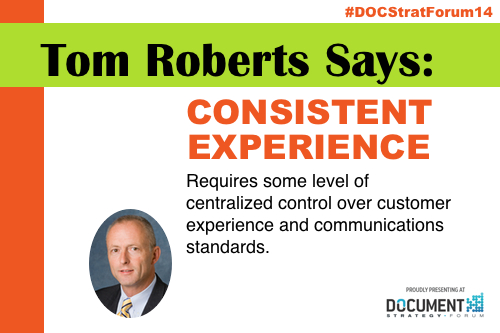
It’s undeniable: The market trend toward multi-channel communications and integrated customer experience is accelerating at an increasing pace. Organizations are rushing to keep up with the demand for change–and to the need to be faster, nimbler and more responsive in a communications environment that’s grown far more complex.
Yet, as these organizations strive to keep up with these demands, they face a number of inhibitors, in the form of:
- Technology Barriers: legacy systems and inadequate tooling
- Process Inefficiencies: siloed business segments and redundant processes
- Organizational Dysfunction: disparate teams, lack of ownership and turf battles
One of the primary steps a firm can take to help address both the organizational and process dimensions is to centralize the oversight and control over message creation and communications standards.
Many of Doculabs’ clients struggle with the topic of centralization versus federation of key customer communication functions. Business segments have different priorities and timeframes in which they need to transact business, which drives a need for autonomy in responding to market forces and business conditions. Yet, the enterprise as a whole is trying to create a consistent experience across all business segments, an experience which includes multiple channels, devices and media. Resolving this dichotomy requires some level of centralized control over customer experience and communications standards.
Most large organizations can’t or won’t centralize all aspects of the communications development life cycle. But in order to drive consistent experience across businesses, channels and devices, there must be a level of control and oversight that can be leveraged across the spectrum. Consider centralizing the following functions and activities:
- Customer experience standards and guidelines
- Writing standards and brand voice
- Document layout and design
- Enterprise control and oversight (governance)
Note that this centralization doesn’t mean one and only one team; in fact, the depth and breadth of skills will likely require more than one team. However, the teams need to be closely connected and potentially report up through the same management structure.
Development and delivery then is left to possibly be federated across the enterprise. This model enables a strong combination of central control to develop the consistent experience, while providing the flexibility of multiple development and delivery teams that can focus on the specific needs of their respective business counterparts.
There is no “one-size-fits-all” solution, but experience teaches us that it is next to impossible to develop consistent messaging and customer experiences without a level of centralized oversight.
Mr. Roberts will be presenting on Tuesday, May 13, 2014 at the DOCUMENT Strategy Forum. Don't miss his Power Session M304/M305 “The Next Chapter: Creating a Seamless Multi-Channel Communications Approach That Really Works.” DOCUMENT Strategy Forum ’14 early registration ends March 6th! Register early and save up to $300. Visit www.DOCUMENTstrategyForum.com.















